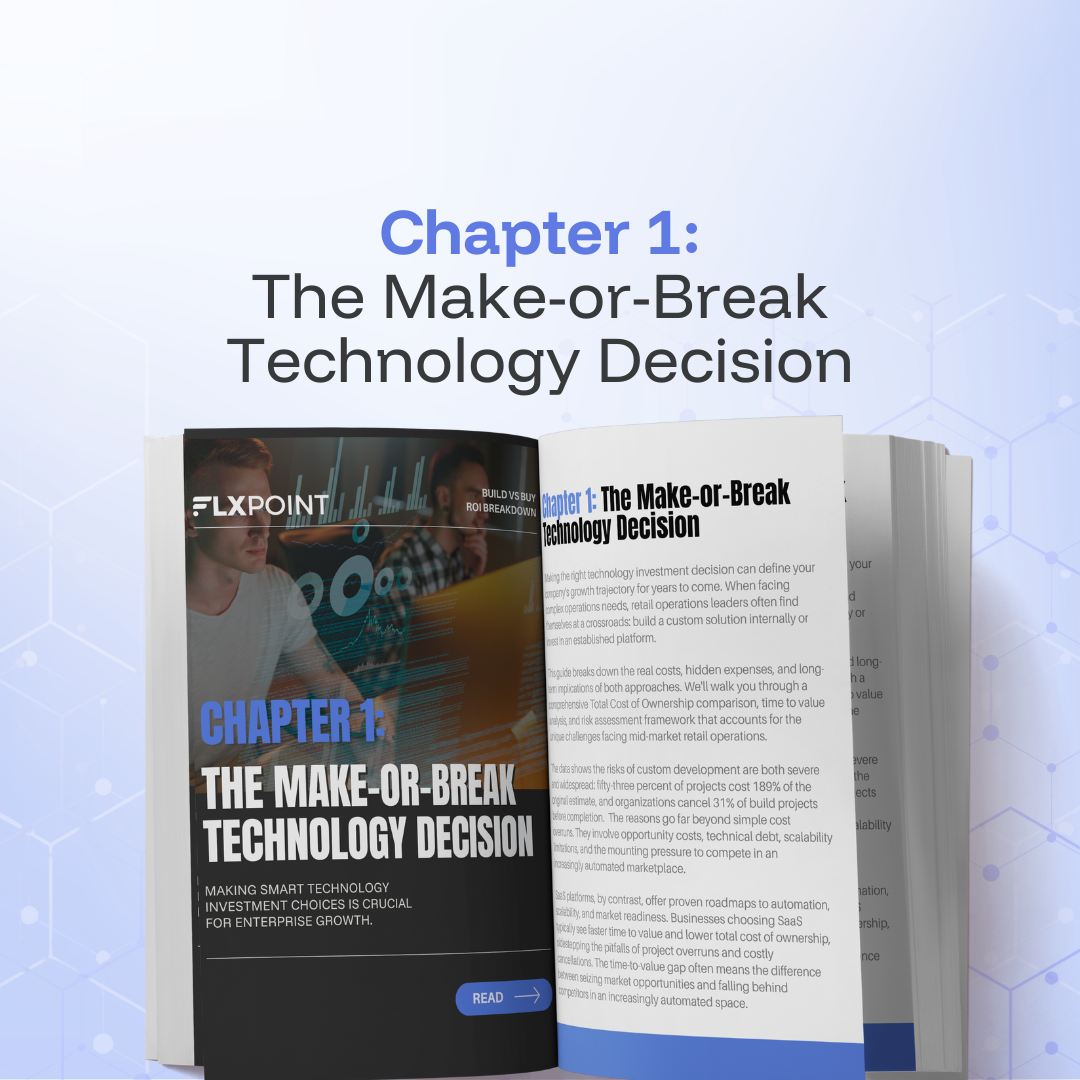Chapter 2 The True Cost of Building
Building custom ecommerce solutions costs far more than anticipated. Developer salaries, ongoing maintenance, integration complexity, and security requirements create hidden expenses. Internal development diverts technical talent from revenue-generating projects while bearing full responsibility for system reliability and compliance.
.png?width=1080&height=1080&name=Build%20vs%20Buy%20ROI%20Breakdown%20(2).png)
When your operations team is drowning in manual processes and your current systems can't handle the complexity of multiple suppliers, EDI requirements, and omnichannel fulfillment, the temptation to build a custom solution in-house feels compelling. After all, who knows your business better than you do?
But here's what most operations leaders discover too late: the real cost of building isn't just the initial development. It's the hidden expenses that compound over time, turning what seemed like a smart investment into a resource-draining nightmare.
The hidden costs and ongoing maintenance create a financial burden that often exceeds expectations by 189% of original estimates.
Developer Time and Opportunity Cost
The foundation of any build decision rests on developer resources. With median software developer salaries ranging from $101,200 to $167,540 annually, every development hour carries significant weight. A typical ecommerce automation platform requires 18-24 months of development time with a team of 3-5 developers.
Consider this calculation:
- Average developer cost: $134,000 annually (including benefits)
- Team size needed: 4 developers
- Development timeline: 20 months
- Total development cost: $890,000
But the real cost extends beyond salaries. Each developer working on internal tools isn't building revenue-generating features for your core business. For companies where technology drives primary revenue, this represents an average opportunity cost of $300,000 per developer over the development timeline.
Companies like Kenneth Cole discovered this when they realized their internal team was spending more time maintaining integrations than building features that drive sales.
Ongoing Maintenance and Updates
Development costs represent only the beginning. Once built, your platform requires continuous maintenance, security updates, and feature enhancements. Industry data shows that maintenance typically consumes 20% of initial development costs annually.
For our example above, that's $178,000 per year in ongoing costs. These expenses compound as your platform grows more complex and integrates with additional systems. Unlike pre-built solutions that distribute maintenance costs across hundreds of customers, you bear the full burden alone.
The maintenance challenge becomes particularly acute as business requirements evolve. What started as a simple inventory sync tool often grows into a complex system handling pricing rules, order routing, vendor management, and financial reconciliation. Each new requirement demands additional development time and increases the maintenance overhead.
Integration Complexity and API Management
Modern ecommerce operations require seamless integration with dozens of systems: marketplaces, suppliers, shipping carriers, accounting software, and inventory management tools. Building these integrations from scratch means understanding and implementing hundreds of API specifications.
Consider the scope required:
- Amazon Seller Central API: Complex product listing, inventory sync, and order management
- Shopify Admin API: Real-time inventory updates and order processing
- EDI connections: Traditional suppliers often require Electronic Data Interchange
- Shipping APIs: UPS, FedEx, USPS for rate calculation and tracking
- Accounting integration: QuickBooks, NetSuite for financial reconciliation
Each integration represents weeks of development time, plus ongoing maintenance as APIs change. Pre-built platforms amortize these integration costs across their entire customer base, making individual connections affordable. Building internally means bearing the full cost of each integration yourself.
Screen Skinz discovered this challenge firsthand. "Sometimes orders, you know, they get missed just because you manually have to click like all the little check boxes and stuff and make sure they get processed through," explains Clay Canning, Co-Founder. Their manual processes created fulfillment gaps that their automation platform (Flxpoint) eliminated entirely.
Security and Compliance Requirements
Ecommerce platforms handle sensitive data: customer information, financial transactions, and proprietary business intelligence. Building secure systems requires specialized expertise that most teams lack internally.
Security requirements include:
- Data encryption: Both at rest and in transit
- Access controls: Role-based permissions and audit trails
- Compliance frameworks: SOC 2, GDPR, PCI DSS where applicable
- Vulnerability management: Regular security assessments and updates
- Backup and disaster recovery: Ensuring business continuity
The cost of security mistakes can be devastating. Data breaches average $4.45 million per incident, and regulatory fines can reach millions more. Pre-built platforms invest heavily in security because it's their core business. They maintain compliance certifications, undergo regular audits, and have dedicated security teams.
When you build internally, these responsibilities and risks become yours alone. Most companies underestimate both the initial cost of implementing proper security and the ongoing expense of maintaining it. The expertise required to do it right often costs more than the entire platform budget.
Resource Allocation Reality Check
Building an ecommerce platform means diverting your best technical talent from revenue-generating projects. For a growing business, this represents a significant opportunity cost that extends far beyond salary expenses.
Consider this scenario: You could spend 20 months building an internal platform, or you could spend that time improving your core product, expanding into new markets, or building features that directly drive customer acquisition. The platform you build may save operational costs, but the features you don't build could have generated millions in additional revenue.
Companies using automation platforms report being able to focus their technical resources on competitive advantages rather than operational infrastructure. This strategic focus often generates returns that far exceed the cost of buying rather than building.
As Black Patch Performance's Jonathan Williams puts it: "The only way to actually scale was to go through Flxpoint... You can't even come close to hiring someone to do what Flxpoint does for the price." The mathematical reality is clear—building costs more than buying, both upfront and over time.
Ready to skip the build headaches and start growing?
Flxpoint offers pre-built integrations, proven security, and expert support that gets you operational in weeks, not years. Book a demo to see how we can accelerate your ecommerce operations.
All Chapters in This Guide

Making smart technology investment choices is crucial for enterprise growth. When internal teams are bogged down by lengthy development cycles while competitors gain market share, it's time to evaluate your decision-making process.
-2.png)
Building custom ecommerce solutions costs far more than anticipated. Developer salaries, ongoing maintenance, integration complexity, and security requirements create hidden expenses. Internal development diverts technical talent from revenue-generating projects while bearing full responsibility for system reliability and compliance.
-2.png)
Beyond obvious development expenses lie devastating hidden costs: operational downtime, team training overhead, scalability limitations, and vendor relationship management. Feature creep expands scope exponentially while technical debt accumulates. These overlooked expenses often exceed visible costs by 2:1 ratios.
-2.png)
Pre-built platforms deliver enterprise-grade reliability, immediate integrations, dedicated support, and continuous innovation that internal teams cannot match. Economies of scale provide predictable scaling costs while shared infrastructure mitigates risks. Professional platforms offer capabilities worth millions at affordable subscription rates.
-2.png)
Successful platform adoption requires strategic phased implementation: assessment, pilot testing, gradual expansion, and full production. Effective change management includes team training, process standardization, and stakeholder communication. Ongoing optimization and success metrics ensure maximum ROI and operational excellence.
Kenneth Cole's Smart Savings With Shopify EDI Connections
"They had never used Flxpoint before. But working with [the Flxpoint] team, they learned it and we're about to onboard our newest footwear partner, and you know that's big business for us.”
Mitul PatelKenneth Cole


How Flxpoint Helped Rifle Supply Automate & Grow
“I went line by line… whatever the inventory number was and cost value was, I calculated it and was blown away by how much that was worth— $300 million worth of product that I added to our web store.”
Chris MekdaraRifle Supply


The Ecommerce Automation Behind Screen Skinz
"Automation is the key to maximizing your volume. [Flxpoint] comes right into our flow — everything's automated. We want it to be quick and efficient. So that's what we love about Flxpoint."
Shaun Brown & Clay CanningScreenSkinz


How Inhaven Transformed Vendor Management with Flxpoint
"We ended up switching to Flxpoint, and it has been a much smoother process. Where it took us six months to get onboarded with the other company, we were up and running in a week or two with Flxpoint."
Ashley ChingInhaven


How Black Patch Performance Scaled Smarter with Flxpoint
"The only way to actually scale was to go through Flxpoint… You can’t even come close to hiring someone to do what Flxpoint does for the price."
Jonathan WilliamsBlack Patch Performance


